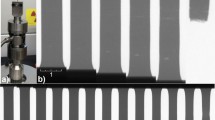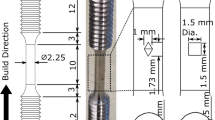Abstract
In this study, the effects of internal pores on the tensile behavior of austenitic stainless steel 316L manufactured with laser powder bed fusion (L-PBF) additive manufacturing (AM) were investigated. Both fully-dense samples and samples with intentional internal pores of varying diameters were fabricated. For each sample with a pore, the internal pore was deliberately fabricated in the center of the cylindrical tensile sample during AM processing. By varying the diameter of the 180 μm-tall initial penny-shaped pores, from 150 to 4800 μm within 6 mm gauge diameter cylindrical samples, the impact of lack-of-fusion, commonly present in AM, as well as the impact of well-defined pores in general, on tensile mechanical properties was studied. To link the pore size and morphology to the mechanical properties, the sizes of the initial pores were evaluated using non-destructive Archimedes measurements, 2D X-ray radiography, 3D X-ray computed tomography, and destructive 2D optical microscopy. Samples with and without the single, penny-shaped pore were subjected to uniaxial tension to evaluate the defect size dependent mechanical properties. The intentional pore began to impact ultimate tensile strength when the pore diameter was 2400 μm, or 16% of the cross-sectional sample area. Elongation to failure was significantly affected when the pore diameter was 1800 μm or 9% of the cross-sectional sample area. This shows that 316L stainless steel manufactured by additive manufacturing is defect-tolerant under uniaxial tension loading.











Similar content being viewed by others
References
DebRoy T, Wei HL, Zuback JS, Mukherjee T, Elmer JW, Milewski JO, Beese AM, Wilson-Heid A, De A, Zhang W (2018) Additive manufacturing of metallic components – process, structure and properties. Prog Mater Sci 92. https://doi.org/10.1016/j.pmatsci.2017.10.001
Sun S, Brandt M, Easton M (2017) Powder bed fusion processes: An overview. In: Laser Additive Manufacturing. pp 55–77
Gu DD, Meiners W, Wissenbach K, Poprawe R (2012) Laser additive manufacturing of metallic components: materials, processes and mechanisms. Int Mater Rev 57:133–164. https://doi.org/10.1179/1743280411Y.0000000014
Cunningham R, Nicolas A, Madsen J, Fodran E, Anagnostou E, Sangid MD, Rollett AD (2017) Analyzing the effects of powder and post-processing on porosity and properties of electron beam melted Ti-6Al-4V. Mater Res Lett 5:516–525. https://doi.org/10.1080/21663831.2017.1340911
Li R, Liu J, Shi Y, Du M, Xie Z (2010) 316L stainless steel with gradient porosity fabricated by selective laser melting. J Mater Eng Perform 19:666–671. https://doi.org/10.1007/s11665-009-9535-2
Sames WJ, List FA, Pannala S, Dehoff RR, Babu SS (2016) The metallurgy and processing science of metal additive manufacturing. Int Mater Rev 61:315–360. https://doi.org/10.1080/09506608.2015.1116649
King WE, Barth HD, Castillo VM, Gallegos GF, Gibbs JW, Hahn DE, Kamath C, Rubenchik AM (2014) Observation of keyhole-mode laser melting in laser powder-bed fusion additive manufacturing. J Mater Process Technol 214:2915–2925. https://doi.org/10.1016/j.jmatprotec.2014.06.005
Vilaro T, Colin C, Bartout JD (2011) As-fabricated and heat-treated microstructures of the Ti-6Al-4V alloy processed by selective laser melting. Metall Mater Trans A 42:3190–3199. https://doi.org/10.1007/s11661-011-0731-y
Cunningham R, Narra SP, Montgomery C, Beuth J, Rollett AD (2017) Synchrotron-based X-ray microtomography characterization of the effect of processing variables on porosity formation in laser power-bed additive manufacturing of Ti-6Al-4V. Jom 69:479–484. https://doi.org/10.1007/s11837-016-2234-1
Morrow BM, Lienert TJ, Knapp CM, Sutton JO, Brand MJ, Pacheco RM, Livescu V, Carpenter JS, Iii GTG (2018) Impact of defects in powder feedstock materials on microstructure of 304L and 316L stainless steel produced by additive manufacturing. Metall Mater Trans A. https://doi.org/10.1007/s11661-018-4661-9
Whittenberger EJ, Rhines FN (1952) Origin of porosity in castings of magnesium-aluminum and other alloys. J Met 4:409–420
Gong H, Rafi K, Gu H, Janaki Ram GD, Starr T, Stucker B (2015) Influence of defects on mechanical properties of Ti-6Al-4V components produced by selective laser melting and electron beam melting. Mater Des 86:545–554. https://doi.org/10.1016/j.matdes.2015.07.147
Mertens A, Reginster S, Paydas H, Contrepois Q, Dormal T, Lemaire O, Lecomte-Beckers J (2014) Mechanical properties of alloy Ti–6Al–4V and of stainless steel 316L processed by selective laser melting: influence of out-of-equilibrium microstructures. Powder Metall 57:184–189. https://doi.org/10.1179/1743290114Y.0000000092
Carlton HD, Haboub A, Gallegos GF, Parkinson DY, MacDowell AA (2016) Damage evolution and failure mechanisms in additively manufactured stainless steel. Mater Sci Eng A 651:406–414. https://doi.org/10.1016/j.msea.2015.10.073
Edwards P, Ramulu M (2014) Fatigue performance evaluation of selective laser melted Ti–6Al–4V. Mater Sci Eng A 598:327–337. https://doi.org/10.1016/j.msea.2014.01.041
Stef J, Poulon-Quintin A, Redjaimia A, Ghanbaja J, Ferry O, De Sousa M, Gouné M (2018) Mechanism of porosity formation and influence on mechanical properties in selective laser melting of Ti-6Al-4V parts. Mater Des doi: https://doi.org/10.1016/j.matdes.2018.06.049
Spierings AB, Schneider M, Eggenberger R (2011) Comparison of density measurement techniques for additive manufactured metallic parts. Rapid Prototyp J 17:380–386. https://doi.org/10.1108/13552541111156504
Haynes R (1971) Effect of porosity content on the tensile strength of porous materials. Powder Metall 14:64–70. https://doi.org/10.1179/pom.1971.14.27.004
Haynes R (1977) A study of the effect of porosity content on the ductility of sintered metals. Powder Metall 20:17–20. https://doi.org/10.1179/pom.1977.20.1.17
Gurson AL (1977) Continuum theory of ductile rupture by void nucleation and growth: part I—yield criteria and flow rules for porous ductile media. J Eng Mater Technol 99:2. https://doi.org/10.1115/1.3443401
McClintock FA (1968) A criterion for ductile fracture by the growth of holes. J Appl Mech 35:363–371. https://doi.org/10.1115/1.3601204
Fadida R, Shirizly A, Rittel D (2018) Dynamic tensile response of additively manufactured Ti6Al4V with embedded spherical pores. J Appl Mech 85:1–10. https://doi.org/10.1115/1.4039048
Slotwinski JA, Garboczi EJ, Hebenstreit KM (2014) Porosity measurements and analysis for metal additive manufacturing process control. J Res Natl Inst Stand Technol 119:494–528. https://doi.org/10.6028/jres.119.019
Yusuf S, Chen Y, Boardman R, Yang S, Gao N (2017) Investigation on porosity and microhardness of 316L stainless steel fabricated by selective laser melting. Metals (Basel) 7:64. https://doi.org/10.3390/met7020064
Thompson A, Maskery I, Leach RK (2016) X-ray computed tomography for additive manufacturing: a review. Meas Sci Technol 27. https://doi.org/10.1088/0957-0233/27/7/072001
De Chiffre L, Carmignato S, Kruth JP, Schmitt R, Weckenmann A (2014) Industrial applications of computed tomography. CIRP Ann - Manuf Technol 63:655–677. https://doi.org/10.1016/j.cirp.2014.05.011
3D Systems ProX® DMP 320. https://www.3dsystems.com/3d-printers/production/prox-dmp-320. Accessed 21 Feb 2017
ASTM International (2018) E1019–18: Standard Test Methods for Determination of Carbon, Sulfur, Nitrogen, and Oxygen in Steel and in Steel, Iron, Nickel, and Cobalt Alloys by Various Combustion and Fusion Techniques
ASTM International (2017) E1097–12: Standard Guide for Determination of Various Elements by Direct Current Plasma Atomic Emission Spectrometry
Riemer A, Leuders S, Thöne M, Richard HA, Tröster T, Niendorf T (2014) On the fatigue crack growth behavior in 316L stainless steel manufactured by selective laser melting. Eng Fract Mech 120:15–25. https://doi.org/10.1016/j.engfracmech.2014.03.008
ASTM International (2016) E8/E8M - 16a: Standard Test Methods for Tension Testing of Metallic Materials
Frazier WE (2014) Metal additive manufacturing: a review. J Mater Eng Perform 23:1917–1928. https://doi.org/10.1007/s11665-014-0958-z
ASM International (2003) Alloy Digest
Schneider CA, Rasband WS, Eliceiri KW (2012) NIH image to ImageJ: 25 years of image analysis. Nat Methods 9:671–675. https://doi.org/10.1038/nmeth.2089
du Plessis A, Yadroitsev I, Yadroitsava I, Le Roux SG (2018) X-ray microcomputed tomography in additive manufacturing: a review of the current technology and applications. 3D Print Addit Manuf 5:1–21. https://doi.org/10.1089/3dp.2018.0060
Feldkamp LA, Davis LC, Kress JW (1984) Practical cone-beam algorithm. J Opt Soc Am A 1:612–619. https://doi.org/10.1364/JOSAA.1.000612
Thermo Fisher Scientific (2018) Avizo Software 9 User’s Guide. 61–101
Mower TM, Long MJ (2016) Mechanical behavior of additive manufactured, powder-bed laser-fused materials. Mater Sci Eng A 651:198–213. https://doi.org/10.1016/j.msea.2015.10.068
Wang YM, Voisin T, McKeown JT, Ye J, Calta NP, Li Z, Zeng Z, Zhang Y, Chen W, Roehling TT, Ott RT, Santala MK, Depond PJ, Matthews MJ, Hamza AV, Zhu T (2017) Additively manufactured hierarchical stainless steels with high strength and ductility. Nat Mater. https://doi.org/10.1038/nmat5021
Acknowledgements
The financial support provided by the National Science Foundation through award number CMMI-1652575 is gratefully acknowledged. Any opinions, findings, and conclusions or recommendations expressed in this material are those of the authors and do not necessarily reflect the views of the National Science Foundation. The samples were fabricated at Penn State’s Center for Innovative Materials Processing through Direct Digital Deposition (CIMP-3D). The authors also express their gratitude to the staff of the Center for Quantitative Imaging (CQI) at Penn State for their help with X-ray CT work.
Author information
Authors and Affiliations
Corresponding author
Additional information
Publisher’s Note
Springer Nature remains neutral with regard to jurisdictional claims in published maps and institutional affiliations.
Allison Beese is a member of the Society for Experimental Mechanics.
Rights and permissions
About this article
Cite this article
Wilson-Heid, A.E., Novak, T.C. & Beese, A.M. Characterization of the Effects of Internal Pores on Tensile Properties of Additively Manufactured Austenitic Stainless Steel 316L. Exp Mech 59, 793–804 (2019). https://doi.org/10.1007/s11340-018-00465-0
Received:
Accepted:
Published:
Issue Date:
DOI: https://doi.org/10.1007/s11340-018-00465-0




